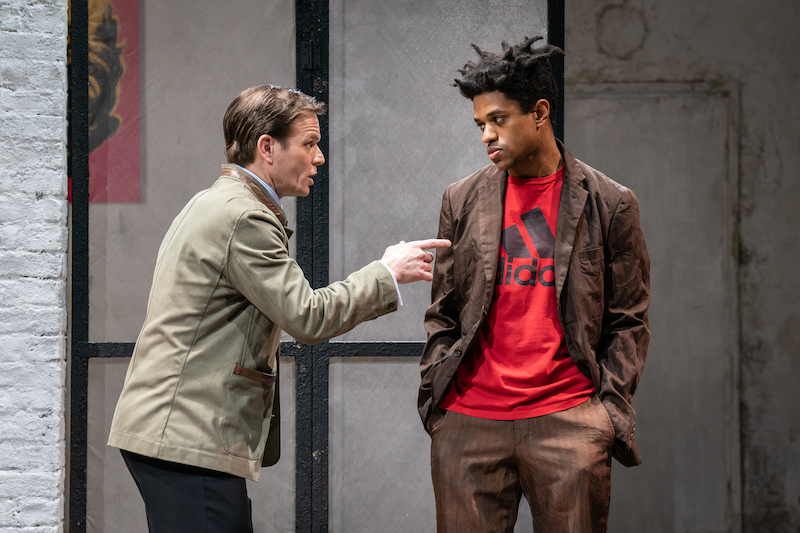At first glance, it was the most unlikely of friendships, even for the solipsistic milieu of the New York art scene. Andy Warhol: crown prince of Pop art, uber-celebrity, one of the most iconic figures in the world; and Jean-Michel Basquiat, the rebellious, dreadlocked, graffiti artist turned neo-expressionist wunderkind. One white, middle aged, his star fading, the other black, in his twenties and on the rise.
And yet, for a few years in the Eighties, they were friends, inseparable ones, as well as highly productive collaborators. Their relationship has been frequently documented, not least by Warhol himself, who was a famously obsessive, pre-social media recorder of his daily life. Anthony McCarten’s new play, directed by Young Vic artistic director Kwame Kwei-Armah, attempts to put some flesh on the bone, to imagine the conversations and the dynamics between this decidedly odd couple.
The result touches on the creative process, the function and value of art, identity and celebrity; but what’s most interesting, and often captivating, is the opportunity it offers Paul Bettany, in a rare stage appearance, and Broadway actor Jeremy Pope to humanise these art legends. Warhol with his wig off, if you like.
On entering the Young Vic, it feels like South East London has been infused with a little bit of Eighties New York. Graffiti is on the walls of the auditorium. The DJ/VJ Xana is playing House music. The back wall of the stage has video projections of NYC – the skyline, the subway, the streets. It’s an engagingly high-energy preamble. McCarten opens with his version of their meeting, orchestrated by the Swiss art dealer Bruno Bischofberger (Alec Newman, pictured above, with Pope) who is representing each man individually and can see the potential in a collaboration, even if both are extremely reluctant.
McCarten opens with his version of their meeting, orchestrated by the Swiss art dealer Bruno Bischofberger (Alec Newman, pictured above, with Pope) who is representing each man individually and can see the potential in a collaboration, even if both are extremely reluctant.
Bruno pitches to each, in turn. “Oh my god. It’s too much… So much anger”, whines Warhol, as he views Basquiat’s work (both viewing and painting are, cutely, in the direction of the audience). While the veteran is aware that he’s “lost a little steam lately” and his work could use a shot in the arm, he’s scared of the usurper and, more than that, of the idea of actually picking up a paintbrush to work alongside him, after years of screen-printing and getting assistants to do his work for him.
For his part, Basquiat thinks that Warhol is old hat. “I’m better than him,” he says with relish. “He’s not a real artist if he doesn’t paint.” But the wily dealer skilfully tweaks their egos, insists that each has something to teach the other. Artists are like boxers, he says, “you need to spill some blood on the canvas”.
From this point, the play is effectively divided into two parts: the first in Warhol’s studio – tidy, minimalist, with signature paintings on the walls – of Marilyn Monroe and the Campbell’s soup can; the second, three years later in Basquiat’s place, which has the air of a squat, with graffiti splattered walls, syringes down the sofa cushion and a refrigerator full of cash, because the suddenly wealthy young man doesn’t trust banks.
In the first, they are wary, combative, with Basquiat challenging Warhol’s dismissive (and disingenuous) idea of art as commerce, which needs represent nothing at all; the second sees them perfectly at ease in each other’s company, though this happy state is about to change.  The leads are excellent, in challenging roles. With the more familiar character, Bettany must capture the scarecrow appearance – gaunt, white features topped by a white wig, freakish but fashionably dressed – and affected mannerisms, without caricature. He does it wonderfully, at once catty, amusing, and deeply vulnerable, particularly when revealing the self-loathing beneath the well-tooled public image.
The leads are excellent, in challenging roles. With the more familiar character, Bettany must capture the scarecrow appearance – gaunt, white features topped by a white wig, freakish but fashionably dressed – and affected mannerisms, without caricature. He does it wonderfully, at once catty, amusing, and deeply vulnerable, particularly when revealing the self-loathing beneath the well-tooled public image.
Pope’s task is to make the quietly spoken, delicate, reticent, drug-addicted Basquiat enough of a presence. He achieves that, largely, through physicality – whether constantly pacing around the stage, or with the energetic, sweeping arcs of his painting (as opposed to Warhol’s tentative little marks), or the wounded passion he expresses when describing the motivation of his own painting – “to raise the dead”.
This abstract, deeply personal desire comes to light when McCarten introduces the brutal killing by New York transit police of Basquiat’s friend Michael Stewart, which lends the play a discomforting parallel to today’s murder of George Floyd. And it’s with the news of Stewart’s death, which brings unresolved questions and tensions between the two men to the boil, that the play – hitherto a little flat – springs into life.
It’s here, too, that McCarten heralds the imminent deaths of both men. “A little bit of fame and you survive hospital,” Warhol declares, wryly. “Too much and you’re dead.” As a whole, it’s entertaining when it might have been electrifying. McCarten could certainly tighten up his plotting: there are holes in the three-year leap between acts; the introduction of Basquiat’s side-lined pregnant girlfriend (Sofia Barclay, pictured above) adds some necessary critique of his personality, but is over-extended; and the conversation about art feels a little rote, rather than revelatory.
As a whole, it’s entertaining when it might have been electrifying. McCarten could certainly tighten up his plotting: there are holes in the three-year leap between acts; the introduction of Basquiat’s side-lined pregnant girlfriend (Sofia Barclay, pictured above) adds some necessary critique of his personality, but is over-extended; and the conversation about art feels a little rote, rather than revelatory.
And while Kwei-Armah has orchestrated a static scenario quite well, and excels with the vibe, he does the collaboration something of a disservice – featuring works as they're still centred on Warhol’s trademark use of iconic images, and missing the synergy of styles that really did take both artists a step forward.
As it happens, it has just been announced that McCarten, who is best known as the screenwriter of the films The Theory of Everything, Darkest Hour and Bohemian Rhapsody, has already adapted The Collaboration for the big screen, with Kwei-Armah, Bettany and Pope to reprise their roles. Film seems like a more natural home for the material and will offer the director the chance to really explore this pair’s extraordinary legacy.















Add comment